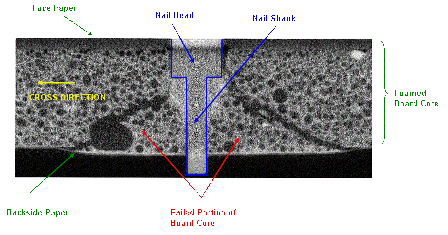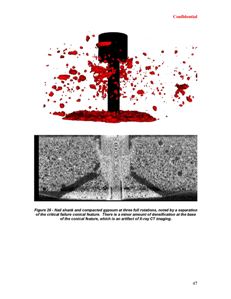Mark Flumiani, Tom Elliot and Bob Bruce
Introduced January 2008
ASTM C473 "Standard Test Methods for Physical Testing of Gypsum Panel Products" covers the test methods for gypsum board. Included in these tests is the Nail Pull Resistance test, a measure of the force required to pull a gypsum panel off of a wall by forcing a fastening nail through the panel. The reported value for Nail Pull Resistance is the maximum stress achieved while the head penetrates through the board surface and core. ASTM C1396 “Standard Specification for Gypsum Board” states the minimum specification limit to be 77 lbs for a 1/2" board.
It is well known in the gypsum industry that the nail pull test represents a significant barrier to further technology advancements in manufacturing cost reduction. The most obvious direction for cost improvement is board weight reduction. This can be accomplished through reduced stucco usage (while simultaneously increasing the amount of foam-produced cellular air voids) and also through reduced liner basis weight. Both parameters are known to be important contributors to nail pull performance and are also the two largest cost components of the gypsum board process: board drying (related to stucco usage and properties) and liner costs. Exactly how the measured nail pull result is achieved is not well understood. Numerous patents have been granted for additives or processes which are described to improve nail pull performance although seldom do these descriptions involve the mechanism for either the test itself or how a particular improvement beneficially alters the mechanism. Understanding this test is the key to manufacturing lightweight gypsum board.
The purpose of this report is to describe the current level of public-domain industry knowledge of nail pull and to design and perform an experiment to further explain factors that are important in the test. Specifically, a theoretical description of the forces present in the test and reported material properties of both gypsum and foam are described, followed by an informal patent search of relevant technologies. Next, an experiment is disclosed that was used to determine the internal failure mechanism of the board core during a nail pull test using Computed Tomography. Further CT data analysis and a selection of peripheral investigative experiments are also included to provide additional explanation. Finally, a proposed mechanism for the test is described in a stepwise manner. Overall, 2 commercial gypsum boards were characterized using this experimental CT nail pull technique.
It is expected that this 66 page report will be applicably informative for industry suppliers and gypsum board producers alike, potentially helping to contribute to future technology development and cost reduction. Included here is a representative example images of a failed board evaluated with Computed Tomography.



